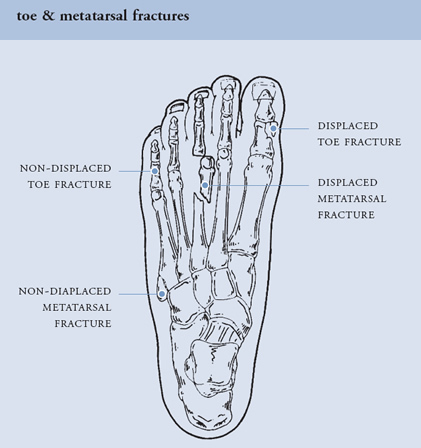Toe and Metatarsal Fractures
The structure of your foot is complex,
consisting of bones, muscles, tendons,
and other soft tissues. Of the 26 bones
in your foot, 19 are toe bones (phalanges)
and metatarsal bones (the long bones
in the midfoot).
Fractures of the toe and metatarsal bones are common and require
evaluation by a specialist. A podiatric foot and ankle surgeon
should be seen for proper diagnosis and treatment, even if initial
treatment has been received in an emergency room.
What is a Fracture?
A fracture is a break in the bone. Fractures can be divided into
two categories: traumatic fractures and stress fractures.
Traumatic Fractures
Traumatic fractures (also called acute fractures) are caused
by a direct blow or impact—like seriously stubbing your toe.
Traumatic fractures can be displaced or nondisplaced. If the
fracture is displaced, the bone is broken in such a way that it
has changed in position (dislocated). Treatment of a traumatic
fracture depends on the location and extent of the break
and whether it is displaced. Surgery is sometimes required.
Signs and symptoms of a traumatic fracture include:
- You may hear a sound at the time of the break
- “Pinpoint pain” (pain at the place of impact) at the
time the fracture occurs and perhaps for a few hours
later, but often the pain goes away after several hours
- Deviation (misshapen or abnormal appearance) of the toe
- Bruising and swelling the next day
- It is not true that “if you can walk on it, its not broken.”
Evaluation by the podiatric surgeon is always recommended
StressFractures
Stress fractures are tiny, hairline breaks that are usually caused
by repetitive stress. Stress fractures often afflict athletes who,
for example, too rapidly increase their running mileage. Or they
may be caused by an abnormal foot structure, deformities, or
osteoporosis. Improper footwear may also lead to stress fractures.
Stress fractures should not be ignored, because they will come
back unless properly treated. Symptoms of stress fractures include:
- Pain with or after normal activity
- Pain that goes away when resting and then returns when
standing or during activity
- “Pinpoint pain” (pain at the site of the fracture) when touched
- Swelling, but no bruising
Sprains
Sprains and fractures have similar symptoms, although sometimes
with a sprain, the whole area hurts rather than just one point.
Your podiatric surgeon will be able to diagnose which you have
and provide appropriate treatment. Certain sprains or dislocations
can be severely disabling. Without proper treatment they can
lead to crippling arthritis.
Consequences of Improper Treatment
Some people say that “the doctor can’t do anything for a
broken bone in the foot.” This is usually not true. In fact,
if a fractured toe or metatarsal bone is not treated correctly,
serious complications may develop. For example:
- A deformity in the bony architecture which may limit
the ability to move the foot or cause difficulty in fitting shoes
- Arthritis, which may be caused by a fracture in a joint
(the juncture where two bones meet), or may be a result
of angular deformities that develop when a displaced
fracture is severe or hasn’t been properly corrected
- Chronic pain and long-term dysfunction
- Non-union, or failure to heal, can lead
to subsequent surgery or chronic pain

Treatment of Toe Fractures
Fractures of the toe bones are almost always traumatic fractures.
Treatment for traumatic fractures depends on the break itself
and may include these options:
Rest Sometimes rest is all that is needed to treat a traumatic
fracture of the toe.
Splinting The toe may be fitted with a splint to keep it in a fixed position.
Rigid or Stiff-Soled Shoe Wearing a stiff-soled shoe protects the toe and helps
keep it properly positioned.
“Buddy Taping” Buddy taping the fractured toe to another toe is sometimes
appropriate, but in other cases it may be harmful.
Surgery If the break is badly displaced or if the joint is affected,
surgery may be necessary. Surgery often involves the use
of fixation devices, such as pins.
Treatment of Metatarsal Fractures
Breaks in the metatarsal bones may be either stress or traumatic
fractures. Certain kinds of fractures of the metatarsal bones
present unique challenges.
For example, sometimes a fracture of the first metatarsal bone
(behind the big toe) can lead to arthritis. Since the big toe is used
so frequently and bears more weight than other toes, arthritis
in that area can make it painful to walk, bend, or even stand.
Another type of break, called a Jones fracture, occurs at the
base of the fifth metatarsal bone (behind the little toe). It is
often misdiagnosed as an ankle sprain and misdiagnosis can have
serious consequences since sprains and fractures require different
treatments. Your podiatric surgeon is an expert in correctly
identifying these conditions as well as other problems of the foot.
Treatment of metatarsal fractures depends on the type and
extent of the fracture and may include:
Rest Sometimes rest is the only treatment needed to promote
healing of a stress or traumatic fracture of a metatarsal bone.
Avoid the Offending Activity Because stress fractures result from repetitive stress, it is
important to avoid the activity that led to the fracture.
Crutches or a wheelchair are sometimes required to offload
weight from the foot to give it time to heal.
Immobilization, Casting, or Rigid Shoe A stiff-soled shoe or other form of immobilization may
be used to protect the fractured bone while it is healing.
Surgery Some traumatic fractures of the metatarsal bones require
surgery, especially if the break is badly displaced.
Follow-Up Care Your podiatric foot and ankle surgeon will provide instructions
for care following surgical or non-surgical treatment. Physical
therapy, exercises and rehabilitation may be included in a schedule
for return to normal activities.
 Back to Conditions & Treatments
Back to Conditions & Treatments
 Appointments Contacts & Location Information
Appointments Contacts & Location Information
 The Podiatrists
The Podiatrists
 FFS Home
FFS Home